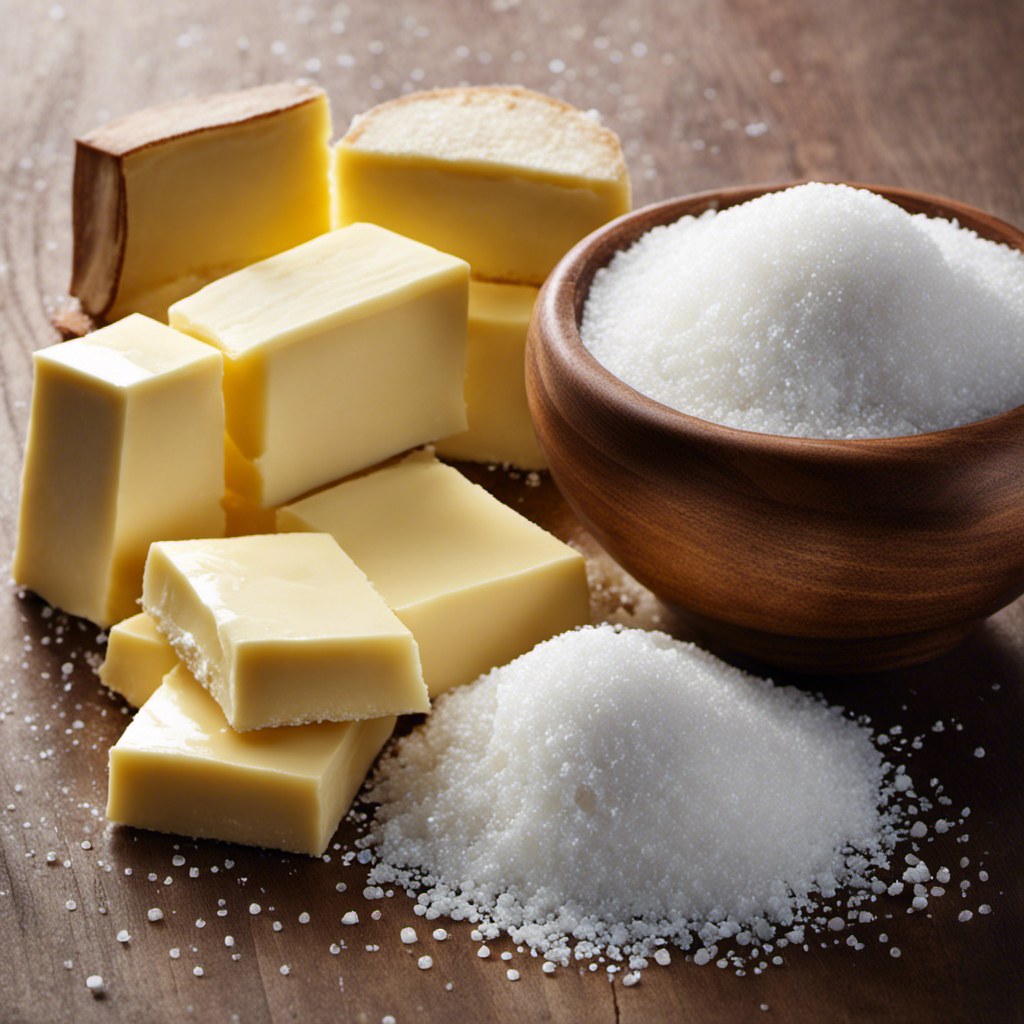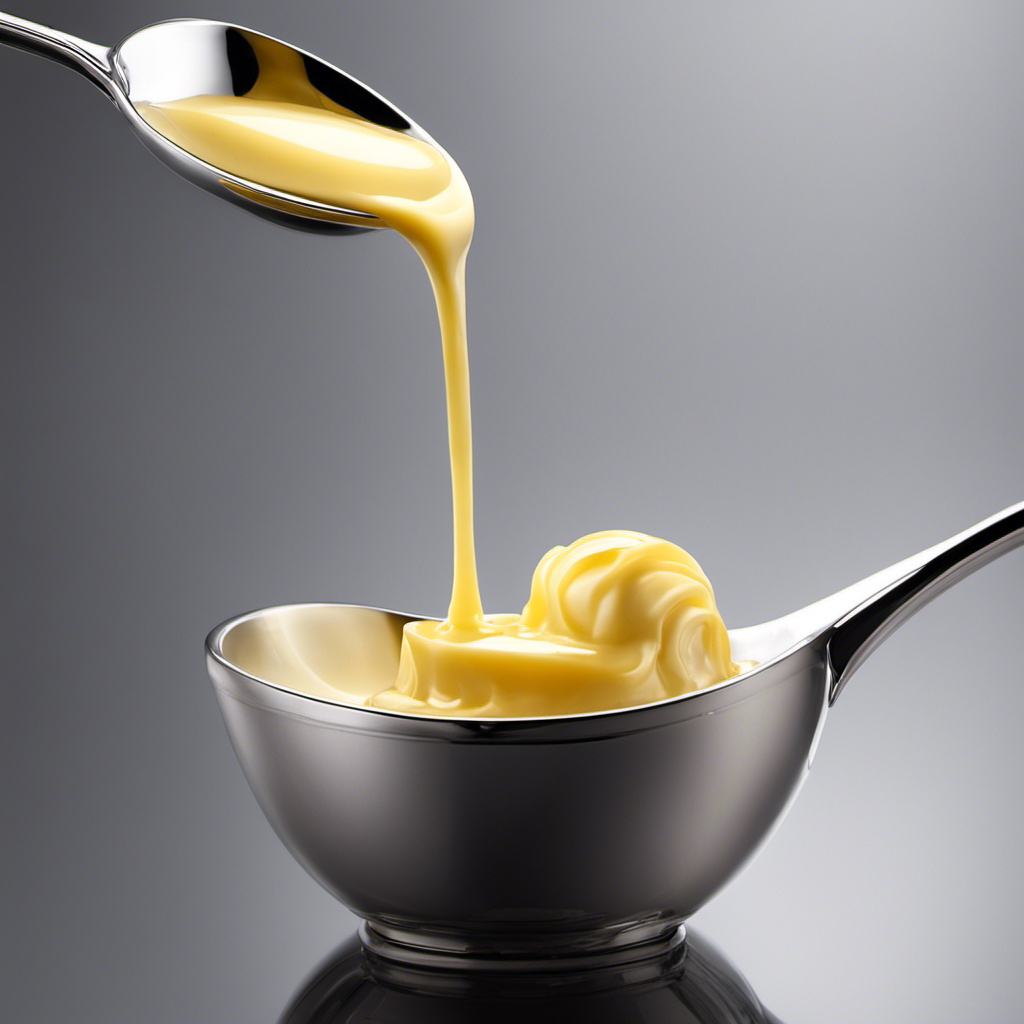I’ve always been curious about how much salt is in butter. It’s one of those common ingredients we frequently take for granted. What’s the actual amount of salt contained within it?
This article aims to shed light on the connection between butter and sodium, decoding the salt content labels on packaging, and comparing salt levels in different brands. We’ll also explore the impact of salt on butter flavor and discuss health concerns surrounding salt consumption.
So, let’s dive in and uncover the truth about how much salt is in butter.
Key Takeaways
- A tablespoon of butter contains approximately 90 milligrams of sodium.
- Salt plays a multifaceted role in butter production, including preserving the butter, stabilizing the fat structure, and enhancing taste.
- Pay attention to salt content labels on butter packaging to make informed dietary choices and reduce sodium intake.
- Excessive salt consumption can lead to health issues such as high blood pressure, heart disease, stroke, kidney disease, osteoporosis, and stomach cancer.
Butter and Sodium: Understanding the Connection
You may be wondering how much salt is in your butter. Butter consumption is a common practice in many households, but its salt content is often overlooked. Understanding the connection between butter and sodium is crucial for maintaining a healthy diet.
On average, a tablespoon of butter contains about 90 milligrams of sodium. While this may not seem like a lot, it can quickly add up if you consume large quantities of butter regularly. Excessive sodium intake has been linked to various health issues, such as high blood pressure and heart disease.
To reduce your sodium intake, consider using salt alternatives in your cooking, such as herbs, spices, or lemon juice. These alternatives can add flavor to your dishes without the added sodium from butter.
The Role of Salt in Butter Production
Adding salt to butter enhances its flavor and aids in the production process. The role of salt in butter production is multifaceted and crucial.
Firstly, salt acts as a preservative, extending the shelf life of butter by inhibiting the growth of bacteria. Additionally, salt plays a vital role in texture development. It helps to stabilize the fat structure in butter, resulting in a smoother and creamier product.
Moreover, salt contributes to the overall flavor profile of butter. It enhances the natural buttery taste and balances the richness, creating a more enjoyable sensory experience.
Understanding the importance of salt in butter flavor is essential for both consumers and producers. By knowing how salt influences the taste and quality of butter, it becomes easier to appreciate the value it brings to our culinary endeavors.
Transitioning into the subsequent section about decoding salt content labels on butter packaging, it is crucial to understand how to interpret the information provided to make informed choices.
Decoding Salt Content Labels on Butter Packaging
When purchasing butter, it’s important to pay attention to the salt content labels on the packaging so you can make informed choices about your dietary preferences. Decoding salt content labels can be a daunting task, but understanding the implications of salt consumption can help you make healthier choices.
Here are four key points to consider:
-
High salt content: Some butter brands may contain higher levels of salt, which can contribute to health issues like high blood pressure and increased risk of heart disease.
-
Low salt options: Look for butter with lower salt content to reduce your sodium intake and promote a healthier lifestyle.
-
Hidden sources of salt: Be aware that even unsalted butter can still have trace amounts of sodium. Always read the labels carefully to know the exact amount of salt in the product.
-
Balance is key: While it’s important to limit salt consumption, remember that our bodies do require some sodium for proper functioning. Finding a balance between taste and health is essential.
Comparing Salt Levels in Different Brands of Butter
When comparing the salt levels in different brands of butter, it becomes evident that there is a significant variation in salt content.
This variation is crucial to consider as it directly affects the health implications of consuming butter with high salt levels.
Additionally, consumer preference for salt plays a significant role in determining which brand of butter individuals choose and the potential impact on their overall health.
Salt Content Variations
You might notice that the salt content in different brands of butter varies. This variation in salt content can have significant health implications. Here are four key points to consider:
-
Low-salt butter: Some brands offer low-salt options, which have a reduced sodium content compared to regular butter. These options are suitable for individuals monitoring their salt intake due to health concerns.
-
Standard salt content: Most brands of butter have a standard salt content, which is typically around 1-2% of the total weight. This level of salt is generally acceptable for individuals without specific dietary restrictions.
-
High-salt butter: There are brands that have a higher salt content, reaching up to 3-4% or more. These options can significantly contribute to daily salt intake and may pose health risks, especially for those with hypertension or heart conditions.
-
Read labels: To make informed choices, it is essential to read the nutritional labels and compare the salt content across different brands. This way, you can select a butter option that aligns with your dietary needs and health goals.
Health Implications of Salt
It’s important to be aware of the health implications of consuming high levels of salt in your diet. Excessive salt intake can have detrimental effects on your health, increasing the risk of various health conditions.
The recommended daily intake of salt is no more than 2,300 milligrams, or about one teaspoon. Consuming excessive salt can lead to high blood pressure, which is a major risk factor for heart disease and stroke. It can also contribute to the development of kidney disease, osteoporosis, and stomach cancer.
Additionally, a high-salt diet has been associated with an increased risk of obesity and water retention. Therefore, it is crucial to monitor your salt intake and make mindful choices to reduce your risk of these health complications.
Consumer Preference for Salt
When it comes to consumer behavior, taste preferences play a crucial role in determining the success or failure of a product. People have different preferences when it comes to the taste of their food, and this includes their preference for salt levels in butter. Understanding consumer preferences for salt in butter can help manufacturers tailor their product to meet the demands of their target market.
Here are four key factors that influence consumer taste preferences:
-
Cultural background: Different cultures have varying levels of salt usage in their cuisine, which can influence individual preferences for salt in butter.
-
Personal health concerns: Some individuals may have specific health conditions that require them to limit their salt intake, leading to a preference for low-salt or salt-free butter.
-
Taste perception: People have different taste sensitivities, and what may be considered too salty for one person could be perfectly balanced for another.
-
Marketing and advertising: Effective marketing strategies can influence consumer perceptions and preferences for salt levels in butter, as well as create new trends and preferences.
The Impact of Salt on Butter Flavor
When it comes to butter, salt plays a crucial role in enhancing its flavor. The addition of salt not only adds a savory note but also affects the overall taste profile of the butter.
Salt Enhances Butter’s Flavor
Adding salt enhances the flavor of butter. It is a common practice to season butter with salt to elevate its taste. Here are four reasons why salt is a crucial component in butter seasoning:
- Salt amplifies the richness of butter, creating a more satisfying and indulgent flavor.
- It balances the natural sweetness of butter, creating a harmonious taste profile.
- Salt adds depth and complexity to the overall flavor, enhancing the butter’s savory notes.
- It helps to preserve and extend the shelf life of butter by inhibiting bacterial growth.
While there are salt alternatives available, such as low-sodium options or herb-infused salts, they may not provide the same level of flavor enhancement as traditional salt. Nevertheless, for those seeking to reduce their sodium intake, exploring these alternatives can still offer a satisfactory butter seasoning experience.
Now, let’s delve into how salt adds savory notes to butter.
Salt Adds Savory Notes
To enhance the savory notes in your butter, consider experimenting with different herbs and spices. Adding a touch of salt to your butter not only helps to enhance its flavor, but it also brings out the umami taste, which is often described as a savory or meaty flavor.
Salt is not only essential in savory dishes, but it also plays a crucial role in baking. In baking, salt not only adds flavor but also helps to strengthen the gluten structure, resulting in a better texture in baked goods.
When it comes to the taste profile, salt affects the overall flavor by balancing and enhancing other flavors in a dish. It can amplify sweetness, reduce bitterness, and add depth to any recipe.
Understanding how salt affects taste is key to creating well-balanced and flavorful dishes.
Salt Affects Taste Profile
Experiment with different herbs and spices to enhance the savory notes in your butter and discover how salt affects the taste profile. Here are four ways salt influences the flavor of butter:
- Salt enhances the natural sweetness of butter, balancing its rich creaminess.
- It helps to suppress any bitter or sour notes in the butter, creating a smoother taste.
- Salt adds depth and complexity, bringing out the nuances of other flavors in the butter.
- It also acts as a flavor enhancer, making the overall taste more pronounced and satisfying.
Considering salt alternatives is important for reducing sodium intake. There are various options available, such as using herbs like thyme or rosemary, or spices like garlic or paprika, to add flavor without relying solely on salt. These alternatives can provide a healthier option for those concerned about their salt intake.
Transitioning to the next section, we will now explore the health concerns surrounding the amount of salt one should consume from butter.
Health Concerns: How Much Salt Should You Consume From Butter
If you’re wondering about your salt intake from butter, how much should you consume for your health?
Portion control is crucial when it comes to consuming butter, especially if you are concerned about your salt intake. Excess salt can have detrimental effects on your health, including an increased risk of high blood pressure and heart disease.
The American Heart Association recommends limiting sodium intake to no more than 2,300 milligrams per day for most adults, and even lower for individuals with certain health conditions. Therefore, it is important to be mindful of the amount of salt in the butter you consume and to practice moderation.
Transitioning into the next section, let’s explore whether salted or unsalted butter is the healthier option.
Salted Vs. Unsalted Butter: Which Is the Healthier Option
When comparing salted and unsalted butter, it’s important to consider which option is healthier for you. Here are four key points to keep in mind:
-
Cholesterol: Butter, regardless of being salted or unsalted, contains cholesterol. However, the difference lies in the amount of sodium added. Salted butter tends to have a higher sodium content, which can negatively impact cholesterol levels in the body when consumed in excess.
-
Impact on Blood Pressure: Excessive sodium intake can increase blood pressure levels. If you are concerned about your blood pressure, opting for unsalted butter may be a better choice to reduce sodium intake.
-
Texture: Salted butter has a distinct taste and texture due to the added salt. It can enhance the flavor of certain dishes, such as baked goods or savory recipes. Unsalted butter, on the other hand, allows for greater control over the overall taste of the dish.
-
Sodium Intake: It’s essential to monitor your sodium intake, as excessive consumption can lead to health issues like hypertension. If you are watching your sodium levels, choosing unsalted butter or using it sparingly may be a more suitable option.
Tips for Reducing Salt Intake From Butter in Your Diet
One effective way to reduce your salt intake from butter in your diet is by opting for unsalted versions. By choosing unsalted butter, you have control over the amount of sodium you consume. Table salt is composed of about 40% sodium, so switching to unsalted butter can significantly reduce your sodium intake.
In addition to unsalted butter, there are other healthy alternatives that can be used in place of butter. These include olive oil, avocado, and nut butters. These alternatives not only provide a source of healthy fats, but also offer additional nutrients and flavors.
Reducing sodium in your diet is important for maintaining overall health. Excessive sodium intake has been linked to high blood pressure, heart disease, and other health issues. By making simple swaps like using unsalted butter or healthy alternatives, you can take steps towards reducing your sodium intake and improving your overall well-being.
| Butter Alternatives | Sodium Content (mg) | Health Benefits |
|---|---|---|
| Unsalted Butter | 0 | Control over sodium intake |
| Olive Oil | 0 | Rich in healthy fats |
| Avocado | 1 | High in fiber and nutrients |
| Nut Butters | 0-5 | Source of protein and healthy fats |
Frequently Asked Questions
What Are the Health Benefits of Consuming Butter With Lower Salt Content?
Consuming butter with lower salt content can have several health benefits. Reduced salt intake lowers the risk of high blood pressure and cardiovascular diseases. Additionally, butter is a good source of essential nutrients like vitamins A, D, E, and K.
Is There a Significant Difference in the Taste of Salted and Unsalted Butter?
Taste comparison between salted and unsalted butter shows a noticeable difference. Salted butter provides a savory flavor while unsalted butter is more neutral. For flavor enhancement alternatives, consider using herbs, spices, or other condiments.
How Does the Process of Butter Production Affect Its Salt Content?
Butter production methods can impact the salt content. Different brands may vary in their salt levels due to variations in processing. Understanding the butter production process is key to determining the salt content in different brands.
Are There Any Alternatives to Butter With Lower Sodium Levels?
There are lower sodium spreads and butter alternatives available. These options can be a healthier choice for individuals looking to reduce their sodium intake. It’s important to read labels and choose products with lower sodium content.
Can Excessive Salt Intake From Butter Consumption Lead to Health Complications?
Excessive salt intake from butter can have a negative impact on cardiovascular health. To reduce salt consumption, consider using alternatives to butter or opting for low-sodium versions. It’s important to be mindful of our daily diet.
Conclusion
In conclusion, understanding the connection between butter and sodium is vital for maintaining a healthy diet.
Just like the delicate balance of flavors in a symphony, the role of salt in butter production adds depth and richness to its taste.
However, it is crucial to be mindful of the salt content labels on butter packaging and compare levels between different brands.
While salt enhances flavor, excessive consumption can lead to health concerns.
Therefore, it is important to choose the right option for you, whether it’s salted or unsalted butter, and consider reducing salt intake from butter in your daily diet.










